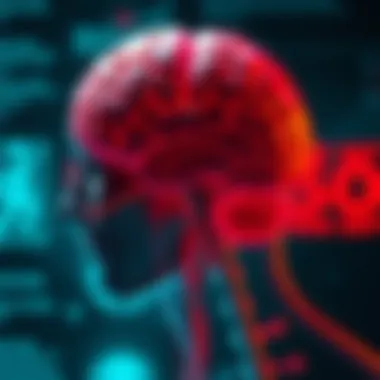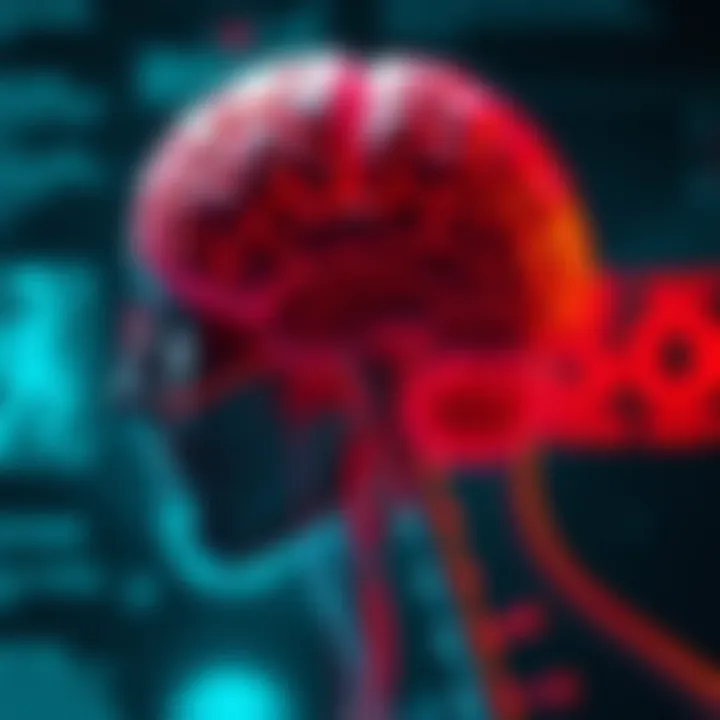Understanding Differences Between Bipolar Disorder and Schizophrenia


Intro
Understanding the distinct characteristics of bipolar disorder type one and schizophrenia is crucial for mental health professionals, students, and anyone interested in psychology. While both are complex mental health disorders, they present unique symptoms and implications, which can lead to confusion. This article aims to clarify their differences, particularly for those seeking deeper knowledge on mental health topics.
With a careful examination of definitions and diagnostic criteria, alongside a review of treatment approaches, this exploration intends to enhance comprehension of these prevalent conditions. The relevance of distinguishing between bipolar disorder type one and schizophrenia cannot be understated; accurate diagnosis and treatment are vital for the well-being of affected individuals.
Understanding Bipolar Disorder Type One
Understanding Bipolar Disorder Type One is pivotal in distinguishing it from other mental health disorders, particularly schizophrenia. With the world increasingly aware of mental health challenges, familiarity with Bipolar Disorder Type One allows individuals, caregivers, and professionals to better identify its nuances and prevalence.
Having a clear grasp of this disorder contributes to early detection and appropriate intervention. Those suffering from bipolar disorder often experience mood fluctuations that can significantly impair their functioning. Recognizing these fluctuations not only helps with personal management but also aids in fostering a supportive environment within families and communities.
Definition and Overview
Bipolar Disorder Type One, often referred to simply as bipolar disorder, is characterized primarily by manic episodes that last at least seven days or by manic symptoms that are so severe that immediate hospital care is needed. Often, episodes of depression can occur as well, generally lasting at least two weeks. The impact of this disorder on an individual’s mood, activity level, and overall daily functioning cannot be understated.
Symptoms of Bipolar Disorder Type One
Manic Episodes
Manic episodes are standout features of Bipolar Disorder Type One. In these episodes, individuals may feel excessively happy, energetic, or irritable. The inherent impulsivity can lead to risky behaviors, such as unplanned spending sprees or reckless driving. What's important about manic episodes is that they contribute significantly to understanding the disorder's impact—these episodes can include symptoms such as decreased need for sleep, racing thoughts, and grandiosity.
Unique to these episodes is how they can lead to significant complications in someone’s life, including strained relationships and job loss. Knowing about these risks can motivate proactive strategies for management.
Depressive Episodes
Conversely, depressive episodes encompass feelings of sadness, emptiness, or hopelessness that last for a minimum of two weeks. People may find themselves withdrawing from activities they once enjoyed or struggling with concentration and indecisiveness. The weight of these depressive episodes can be suffocating, sometimes leading individuals to question their self-worth or contemplate self-harm.
The stark contrast between these depressive states and manic episodes showcases the disorder’s cyclical nature, offering insight into emotional volatility that requires attention and understanding.
Mixed Features
Mixed features refer to the simultaneous presence of hypomanic and depressive symptoms. This unique aspect can be particularly challenging, as individuals may experience high energy coupled with feelings of sadness or irritability. It complicates the clinical picture, making it more difficult both for the individual and healthcare professionals to identify the phase of the disorder.
Recognizing the mixed features can guide targeted treatment options and improve prognosis, ensuring a more tailored approach to management.
Causes and Risk Factors
Genetic Factors
Genetics plays a role in the risk of developing Bipolar Disorder Type One, with family history being a notable indicator. Individuals with close relatives who have the disorder are at higher risk, suggesting a hereditary component. This knowledge can provide crucial insight for early screening and intervention strategies in at-risk populations.
However, a genetic predisposition doesn’t fully guarantee an individual will develop the disorder, highlighting the multifactorial nature of its etiology, which leads to deeper investigation into individual biological makeup.
Environmental Triggers
Environmental influences, such as traumatic experiences, considerable stressors, or major life changes can act as triggers for manic or depressive episodes. Understanding these triggers is essential for managing symptoms. By identifying environmental factors that contribute to the disorder's course, individuals and healthcare providers can develop tailored strategies to minimize risks and enhance coping mechanisms.
Diagnosis of Bipolar Disorder Type One
Clinical Interviews
The diagnostic process for Bipolar Disorder Type One often begins with comprehensive clinical interviews. This method allows clinicians to gather detailed patient histories, enabling an informed assessment of mood patterns. The nuances captured in these dialogues are invaluable in forming an accurate diagnosis, as patients often present with a wide array of symptoms that can mimic other mental health disorders despite the underlying differences.
Diagnostic Criteria
The diagnostic criteria outlined in the DSM-5 serve as a standardized tool for healthcare professionals. By adhering to these criteria, a consistent framework emerges for diagnosing Bipolar Disorder Type One. This adherence is crucial for ensuring that individuals receive appropriate care and treatment for their specific needs, steering clear from misdiagnosis which might otherwise complicate their path to recovery.
Treatment Options
Medication
Treatment for Bipolar Disorder Type One frequently involves pharmacological options aimed at mood stabilization. Options such as mood stabilizers and antipsychotic medications are central to management strategies. The efficacy of medication can vary based on individual responses, often necessitating tailored approaches that consider previous treatment successes and side effects.
Understanding the diverse types of medications available supports informed decision-making regarding treatment paths, ensuring that those affected can engage in discussions with healthcare providers about their options.
Psychotherapy
Alongside medications, psychotherapy is a major component of treatment. Cognitive-behavioral therapy (CBT), for instance, assists individuals in altering detrimental thought patterns and behaviors associated with their disorder. The synergy between therapy and medications can significantly enhance treatment outcomes, driving home the idea that a multifaceted approach is often essential.


Lifestyle Changes
Integrating lifestyle changes can also be beneficial. This includes regular sleep patterns, exercise, and nutrition. Simple yet significant adjustments to daily routines can bolster overall well-being and complement other treatment modalities. Balancing self-care with managed expectations helps build resilience against mood swings and symptom fluctuations.
Understanding Bipolar Disorder Type One is essential for distinguishing it within the wider landscape of mental health disorders, offering patients and caregivers the insights needed to manage its complexities.
Understanding Schizophrenia
Understanding schizophrenia is crucial in distinguishing it from bipolar disorder type one, as the two disorders share some overlapping symptoms yet manifest very differently. By delving into the unique characteristics, underlying mechanisms, and treatment options available for schizophrenia, this article aims to clarify misconceptions and enhance the understanding of mental health conditions. Knowledge about schizophrenia not only assists professionals in accurate diagnosis and effective treatment but also raises awareness among the general public, thus fostering a more supportive environment for those affected.
Definition and Overview
Schizophrenia is a chronic and severe mental disorder that affects how a person thinks, feels, and behaves. It is not a split personality, which is a common misconception, but a condition that can severely disrupt daily functioning and perception of reality. People dealing with schizophrenia often grapple with distorted thinking, delusions, and hallucinations, which can significantly impair their ability to interact socially and maintain a sense of normalcy in their lives.
Symptoms of Schizophrenia
The symptoms of schizophrenia typically fall into three main categories: positive symptoms, negative symptoms, and cognitive symptoms, each representing different aspects of the disorder. Understanding these symptoms is vital, as they paint a comprehensive picture of what individuals with schizophrenia may experience.
Positive Symptoms
Positive symptoms are characterized by the presence of abnormal behaviors or thoughts, which can include hallucinations (seeing or hearing things that aren’t there), delusions (strongly held false beliefs), and disorganized thinking. These symptoms contribute greatly to the stigma surrounding schizophrenia, often leading to fears and misunderstandings about the condition.
A notable feature is that positive symptoms can vary in intensity over time; during acute episodes, individuals may be completely consumed by their hallucinations or delusions, making it critical for timely intervention. Nonetheless, managing these symptoms through appropriate treatment can lead to improved outcomes, although these manifestations can be particularly challenging for both the individual and their loved ones.
Negative Symptoms
Negative symptoms refer to a decrease in emotional expression, motivation, and social engagement. This includes a lack of pleasure in daily activities, social withdrawal, and a reduced ability to initiate and maintain activities, making it difficult for individuals to engage with others or pursue goals. Negative symptoms can often be less visible than positive ones but are equally, if not more, debilitating.
An important aspect of negative symptoms is that they can lead to significant isolation. This isolation not only affects the individual’s quality of life but also poses a challenge for caregivers and family members who may struggle to support someone who is emotionally withdrawn and unresponsive. Understanding this dimension of the disorder is essential for effective support and treatment strategies.
Cognitive Symptoms
Cognitive symptoms can impact memory, attention, and the ability to process information. Individuals with schizophrenia may experience difficulty in concentrating, remembering events, or making decisions. While these symptoms may not be as pronounced as the positive or negative symptoms, they can significantly interfere with daily functioning and quality of life.
Cognitive challenges often contribute to barriers in achieving educational or occupational goals for affected individuals. Acknowledging this area reinforces the need for comprehensive approaches in treatment that address not just manifest symptoms, but also cognitive aspects influencing day-to-day living.
Causes and Risk Factors
The exact causes of schizophrenia remain unclear. However, research indicates that a combination of genetic predispositions and environmental influences play a significant role in its development.
Genetic Predispositions
Genetic predispositions refer to hereditary factors that may increase an individual’s risk of developing schizophrenia. Studies suggest that having a family history of schizophrenia can heighten susceptibility, though it is essential to remember that genetics alone doesn't determine who will develop the disorder.
Understanding genetic influences is beneficial because it can inform early intervention strategies and aid in risk assessment for those with affected family members. However, this aspect can also lead to misunderstanding—many individuals may fear they will inevitably develop schizophrenia simply because of genetic links, leading to unnecessary anxiety.
Environmental Influences
Environmental influences encompass a wide array of factors, including prenatal exposure to infections, psychosocial stressors, and drug abuse—particularly during adolescence. This aspect highlights the complex interplay between genetic factors and life experiences.
Recognizing these influences can bolster preventive measures and promote healthier environments—especially in vulnerable populations. Yet, attributing the disorder solely to environmental factors can overlook the biological complexities of schizophrenia, thereby complicating public perception.
Diagnosis of Schizophrenia
Proper diagnosis of schizophrenia involves a careful evaluation that distinguishes it from other mental health conditions, especially those with overlapping symptoms like bipolar disorder.
Psychiatric Evaluation
A psychiatric evaluation serves as the cornerstone for diagnosing schizophrenia. This involves a thorough assessment by a qualified mental health professional who gathers a detailed history of the individual's mental and physical health, alongside a description of symptoms.
The importance of this evaluation lies in its holistic approach; professionals must consider the individual's context, including history, lifestyle, and potential triggers. However, this process can also face challenges, as individuals may not always fully articulate their experiences due to the cognitive or negative symptoms present.
Diagnostic Tools
In addition to clinical evaluations, diagnostic tools such as standardized assessment questionnaires are also used to aid in confirming a diagnosis. These tools help clinicians gauge the severity and impact of symptoms on daily life.
The use of reliable diagnostic tools enhances the accuracy of assessments, although reliance on such tools necessitates a comprehensive understanding of the individual’s unique context—no single questionnaire can capture the full spectrum of schizophrenia symptoms.
Treatment Strategies
Treating schizophrenia is a multifaceted approach aimed at managing symptoms and improving the quality of life.


Antipsychotic Medications
Antipsychotic medications are the primary treatment for schizophrenia, functioning by altering the brain's chemical balance. The characteristic of these medications lies in their ability to mitigate positive symptoms, although they do not completely cure the disorder.
While many individuals find relief from their symptoms through medications, potential side effects, which may include weight gain or other metabolic issues, warrant careful consideration. This complexity illustrates why ongoing management and adjustment of treatment plans are essential in the therapeutic process.
Therapeutic Interventions
In conjunction with medication, therapeutic interventions—such as cognitive behavioral therapy (CBT)—can play a pivotal role in treatment. CBT helps individuals develop coping strategies and skills to manage symptoms effectively.
Moreover, these interventions foster a supportive environment, encouraging clients to engage in meaningful relationships and activities. However, incorporating therapy into a treatment regimen relies on the individual’s motivation and willingness to participate, presenting a challenge in some cases.
Understanding schizophrenia through these layered discussions not only illuminates its complexity but also emphasizes the need for comprehensive care that encompasses all dimensions of the disorder. By examining the linked aspects of symptoms, causes, diagnosis, and treatment, we open the door to fostering insightful dialogues and reducing stigma, which ultimately serves those affected more effectively.
Comparative Analysis of Bipolar Disorder Type One and Schizophrenia
This analysis sheds light on overlapping symptoms, essential differences, and the broader implications for therapeutic strategies and social perceptions. The ongoing exploration into how these disorders intersect and diverge enables not only a better grasp of their clinical features but also helps in shaping public understanding and reducing the stigma surrounding mental health.
Similarities Between the Two Disorders
Psychotic Features
Both bipolar disorder type one and schizophrenia can manifest psychotic features, which create a significant common ground between the two conditions. Psychosis in these disorders often includes hallucinations or delusions, which can stir fear and misunderstanding among those who experience them, as well as their families. The key characteristic of psychotic features is their ability to distort reality, leading individuals to perceive situations in ways that differ greatly from their actual state. This overlap serves as a critical point of exploration in this article, highlighting how similar symptoms can arise from fundamentally varied mental health issues.
While hallucinations in schizophrenia may be more consistent and pervasive, those with bipolar disorder might only encounter these symptoms during manic or severe depressive episodes. Thus, this article benefits from examining this unique feature, which emphasizes the need for tailored therapeutic approaches. The dual nature of psychotic features emphasizes the necessity of distinguishing between these disorders during diagnosis, which can influence treatment efficacy.
Impact on Daily Functioning
Examining the impact on daily functioning presents another layer of understanding. Both bipolar disorder type one and schizophrenia can severely disrupt an individual's ability to engage with daily life effectively. A key characteristic here is that both disorders can lead to difficulties in maintaining relationships, employment, and general day-to-day activities due to their profound effects on an individual’s mood and perception.
Individuals with bipolar disorder may experience notable fluctuations in their energy levels and moods, potentially wreaking havoc on their social and professional lives. Conversely, someone diagnosed with schizophrenia might grapple with pervasive confusion or disengagement from reality, which can inhibit their ability to function in everyday environments. Understanding these nuances provides a clearer picture of their unique features: while bipolar disorder's impact might oscillate, schizophrenia's potential for constant disruptions requires different resources and intervention strategies, making this distinction crucial for effective care.
Key Differences in Symptoms
Nature of Mood Episodes
The nature of mood episodes is a significant differentiator between the two disorders. In bipolar disorder type one, episodes can swing dramatically between manic and depressive states, often with periods of stability in between. This cyclical nature has a profound influence on an individual’s experience and behavior. The manic phase can be characterized by extreme elation, high energy, and impulsivity, whereas the depressive phase can bring an overwhelming sense of sorrow and fatigue.
In contrast, schizophrenia is not characterized by mood swings in the same way. Although some individuals with schizophrenia may experience emotional blunting or flat affect, their symptoms mainly revolve around cognitive disturbances and sensory perceptions. By highlighting this crucial difference, the article lays down the groundwork for understanding how tailored treatment protocols must account for these distinct mood presentations. This understanding can connect to enhanced intervention strategies, ensuring that individuals receive the appropriate support aligned with their specific symptoms.
Types of Psychotic Symptoms
Delving deeper into psychotic symptoms reveals further distinctions between the disorders. In bipolar disorder type one, psychotic symptoms typically surface only during manic or severe depressive episodes. They often manifest as grandiosity during manic phases or feelings of worthlessness in depressive states. This situational aspect sets a tangible dividing line with schizophrenia, where psychotic symptoms, including hallucinations and delusions, can be chronic and not necessarily tied to mood fluctuations.
By emphasizing these key characteristics, the article underlines the importance of recognizing context in psychotic manifestations. This distinction can impact treatment approaches since those with bipolar disorder might not require the same long-term antipsychotic strategies often prescribed for schizophrenia. Grasping these differences can significantly shape therapeutic approaches and patient outcomes.
Differences in Diagnostic Criteria
The diagnostic criteria for these disorders also stand apart. The American Psychiatric Association's Diagnostic and Statistical Manual of Mental Disorders (DSM-5) outlines precise criteria that distinguish between bipolar disorder and schizophrenia. This necessitates a thorough understanding of symptoms and their duration, which is paramount in ensuring accurate diagnosis and treatment. Recognizing these criteria can aid practitioners and patients alike in navigating the sometimes murky waters of mental health classification.
Treatment Disparities
Medication Protocols
When it comes to treatment, medication protocols diverge significantly between bipolar disorder type one and schizophrenia. Those diagnosed with bipolar disorder might respond well to mood stabilizers such as lithium or certain atypical antipsychotics. In contrast, individuals with schizophrenia often rely heavily on antipsychotic medications to manage their symptoms. This divergence reflects the biological underpinnings that necessitate targeted pharmacological interventions.
Highlighting these medication protocols, the article serves as a useful guide for understanding how treatment regimens directly correlate with the underlying pathology of each disorder, laying bare the necessity for customized therapeutic strategies.
Adjunct Therapies
Adjunct therapies add another layer to the treatment landscape. For bipolar disorder type one, strategies like cognitive-behavioral therapy or family-focused therapy often play pivotal roles in coping strategies and education. Conversely, holistic and psychosocial interventions tend to be more prevalent in schizophrenia treatment, addressing dual diagnosis issues, social skills training, and community support needs. By detailing these adjunct therapies, it's evident that treatment options must align closely with the specific challenges posed by each disorder, fostering individualized care that encompasses various dimensions of a patient’s life.
Recent Research Developments
The landscape of mental health research is constantly evolving, shedding new light on conditions like bipolar disorder type one and schizophrenia. Recent developments in research not only enhance our understanding but also drive better approaches to treatment and care. By focusing on cutting-edge studies, researchers hope to refine diagnostic criteria, discover innovative therapeutics, and ultimately diminish the stigma surrounding these complex disorders. Understanding these new insights is paramount in developing better frameworks for mental health awareness and intervention.
Emerging Insights in Bipolar Disorder Type One
Neurobiological Findings
Recent neurobiological findings present a fascinating glimpse into the brain structures and functions that may contribute to bipolar disorder type one. Studies utilizing advanced imaging techniques, such as functional MRI, have highlighted abnormalities in brain regions associated with emotion regulation, decision-making, and impulse control. These discoveries indicate a potential biological underpinning for the mood swings typical of this disorder.


One key characteristic of these findings is the focus on neurotransmitter imbalances. Specifically, disruptions in serotonin and dopamine pathways have been observed in individuals experiencing manic and depressive episodes. This direct link provides a solid foundation for treatment options, as it suggests that biomarker-targeted therapies may yield better outcomes. However, it's important to underscore that while these neurobiological findings offer exciting possibilities, they also present challenges. For instance, the variability in individual brain chemistry means that a one-size-fits-all approach to treatment will unlikely suffice. The unique aspect of these findings lies in their ability to inform personalized treatment plans that take into consideration individual brain function and biology.
Longitudinal Studies
Longitudinal studies play a critical role in understanding how bipolar disorder unfolds over time. By following individuals diagnosed with this condition across several years, researchers gather data that reveal patterns and predictors of mood episodes. This research methodology is essential as it highlights not just single episodes of mania or depression but also the ongoing nature of the disorder.
A significant advantage of longitudinal studies is the potential to identify early markers for mood episodes, allowing for timely intervention. Early identification can significantly improve quality of life and reduce the likelihood of severe episodes. However, these studies are not without their disadvantages. The need for long-term participant engagement poses several practical challenges, including attrition and the impact of external variables over time. Despite these challenges, the unique feature of longitudinal studies is their capacity to paint a comprehensive picture of the progression and treatment of bipolar disorder, offering profound insights into its chronic nature and the effectiveness of various interventions.
Advancements in Schizophrenia Research
Genetic Studies
When delving into schizophrenia, genetic studies provide invaluable insights. The heritability of schizophrenia is substantial, with estimates suggesting that genetics account for approximately 80% of risk. Advances in genomic technologies have allowed scientists to identify specific genes associated with increased vulnerability to the disorder. Notably, common genetic variants linked to brain signaling pathways have surfaced as critical factors in the development of schizophrenia.
These genetic studies have two important features: firstly, they pave the way for understanding the biological basis of schizophrenia, and secondly, they hold the potential for precision medicine. This approach implies that identifying genetic susceptibilities can lead to tailored treatment options that are more effective. However, one downside is that focusing solely on genetic factors might overshadow the environmental influences that also play a vital role in the onset and course of the disorder. The ongoing challenge lies in integrating genetic insights with psychosocial factors for a holistic understanding of schizophrenia.
Psychosocial Interventions
On the psychosocial front, interventions designed for individuals with schizophrenia have made significant strides over the years. Emerging approaches include cognitive behavioral therapy, community support programs, and integrated care models that address both mental health and social needs. These interventions are critical, as they can significantly improve functional outcomes and quality of life.
A key characteristic of these psychosocial interventions is their focus on recovery and empowerment rather than just symptom management. They aim to enhance coping mechanisms, social skills, and community involvement. This approach is beneficial as it recognizes that mental health is not only about managing symptoms but also about fostering a fulfilling life. Nevertheless, one might argue that while psychosocial techniques can be incredibly effective, they may not always reach individuals who are hesitant to engage or lack access to such services. The unique advantage of these interventions is their adaptability to individual circumstances, promoting a tailored approach to recovery.
Understanding recent research developments is crucial to dismantling the stigma associated with mental health issues and fostering informed conversations in society.
Implications for Society and Mental Health
The implications of Bipolar Disorder Type One and schizophrenia on society and mental health are profound, extending beyond individual experiences to broader community impacts. Understanding these conditions is crucial, not only for those directly affected but also for society at large. Mental health issues, including these two disorders, often carry significant social stigma, which affects how individuals are treated in various settings. Addressing stigma is essential for fostering mental wellness and ensuring that affected individuals receive support and understanding rather than discrimination.
Stigma Surrounding Mental Illness
The stigma associated with mental illness, particularly bipolar disorder and schizophrenia, remains prevalent in various cultures. This stigma often leads to social exclusion, where individuals may find themselves isolated or viewed through a lens of misunderstanding. For many, the labels of being 'crazy' or 'unstable' can overshadow their individuality, reducing them to their disabilities.
- Consequences of Stigma:
- Fear of being judged may deter individuals from seeking treatment or speaking about their experiences.
- Stigmatization can exacerbate feelings of loneliness and hopelessness, making recovery more arduous.
The stereotypes surrounding these conditions can lead to misinterpretation of behaviors. For instance, manic episodes in bipolar disorder may be seen as reckless behavior, while hallucinations in schizophrenia may be mistakenly perceived as danger to society. To counteract this, education and awareness campaigns are vital. They help demystify these disorders, shaping public perceptions more positively and accurately.
“Mental health issues are less about the individual, and more about how we as a society respond to them.”
In tackling stigma, including educational initiatives, peer-support programs, and community outreach can play key roles in changing mindsets.
Impact on Family and Community
Families of individuals with bipolar disorder and schizophrenia often bear the brunt of the emotional and logistical challenges these disorders present. The strain on family dynamics can be immense, creating a ripple effect of stress and anxiety. Different family members might respond in unique ways, leading to misunderstandings or conflict rather than support.
- Family Dynamics:
- Caregivers often experience burnout from trying to provide support while managing their own emotions.
- Communication may become strained, as family members struggle to comprehend the complexities of the disorders.
Moreover, communities can feel the impact through the need for additional resources and support systems. The increased demand for mental health services results in a heavier load for local health systems. Communities that offer understanding and resources typically foster an environment that encourages recovery and acceptance.
- Community Benefits of Support:
- Increased awareness can lead to better integration of affected individuals, enhancing social cohesion.
- Local programs aimed at mental health education can bring positive changes in public perception, reducing fear and enhancing empathy.
Ultimately, the collective approach toward understanding and supporting those with these disorders not only uplifts individuals but strengthens entire communities. The path to better mental health, marked by understanding and acceptance, can transform societal attitudes, allowing anyone to thrive regardless of their mental health challenges.
End
Understanding the differences between bipolar disorder type one and schizophrenia has profound implications for individuals, families, and society as a whole. This article highlights these distinctions, helping to demystify two conditions that, although often misclassified, have distinctly different characteristics and treatment methodologies. Such comprehension benefits not only mental health professionals but also those who are experiencing symptoms or caring for someone affected by these disorders.
Emphasizing the unique features of each condition allows for tailored approaches that can lead to more effective management strategies. Accurate knowledge fosters compassion and encourages prompt treatment, minimizing the stigma that often surrounds mental illness.
Moreover, as awareness spreads, communities become more supportive environments through education and resources. The understanding generated by this exploration contributes to a ripple effect that transcends individual experiences.
Summary of Key Points
- Bipolar disorder type one is primarily characterized by significant mood swings, whereas schizophrenia is marked by disruptions in cognition and perception.
- The symptoms of bipolar disorder include manic, depressive, and mixed episodes, while schizophrenia encompasses positive, negative, and cognitive symptom categories.
- Diagnosis for each condition relies on distinct criteria; bipolar disorder diagnosis focuses on mood episodes, while schizophrenia assessment evaluates psychotic features.
- Treatment for bipolar disorder typically involves mood stabilizers or antipsychotic medications and psychotherapy, whereas schizophrenia often includes antipsychotic medications and various therapeutic interventions.
- Recent research highlights progress in identifying biomarkers for both disorders, as well as understanding how social factors influence patient outcomes.
Future Directions for Research
Future explorations in understanding bipolar disorder type one and schizophrenia should continue to refine diagnostic tools and treatment options. Here are several prospective pathways:
- Longitudinal Studies: Understanding the progression of disorders over time can yield insights into effective interventions and long-term management strategies.
- Genetic Research: Genetic studies might elucidate the hereditary aspects, leading to early detection and tailored treatments targeting genetic predispositions.
- Neuroscience Advances: Continued investigation into brain structure and function could help delineate the neurological underpinnings of both disorders.
- Public Health Initiatives: Research should also seek to measure the societal impact of mental illness, examining how support systems affect recovery and quality of life.
In summary, synthesizing current knowledge about bipolar disorder type one and schizophrenia is essential for fostering better treatments and increasing awareness. The aim of future research must remain on enhancing quality of life for those afflicted while reducing societal stigma.















